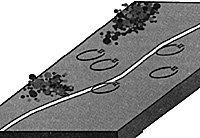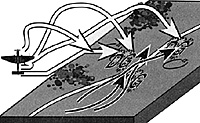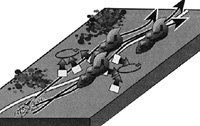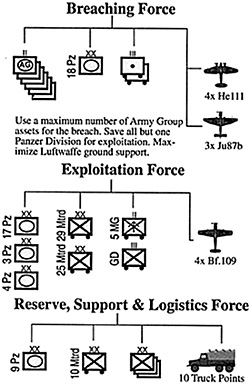By now, quite a few of you have had a chance to experience the command of the German army in Guderian's Blitzkrieg. As far as I know, this is the first game to correctly simulate blitzkrieg-style tactics in a non-linear fashion. Since that is so, numerous players have been slapped upside the head by their game-leamed warfighting tactics when they tried to apply them in that game.
Operational land wargames for many years have masterfully simulated one war (regardless of period of the game itself) and one war alone-World War I. Offensives are handled as broad front affairs with only limited exploitation. Most exploitation seen in games consists of aminor advance and turn to "surround with ZOCs" more of the enemy front line.
Deep penetration only has the effect of taking aplayer's good units out of where the action is, in effect, out of the war. Even games like Fire In the East/Scorched Earth or War In the East which purport to show the active fluid operations on the Eastem Front bog down after the initial turns of Barbarossa into what Owen termed the "snake-dance" where two lines stretching from Finland to the Black Sea wrestle with each other for a hex or two, here and there. Broad front offensives of little depth are the order of the day. Exploitation is almost nonexistent, and when it does occur it is quite limited.
It comes as no surprise that a player trained in such an atmosphere would get a wake up call in his first play of GB. To help out, I have attempted to describe here the basics of a blitz-style offensive in general terms. I have also endeavored to include examples from the play of GB to help illustrate the concepts.
Basics
 Given the situation in figure 1 at right, the German player must attack and advance against the Soviet forces to his front-coming from left to right. To do so, he must apply two simple principles-attack along a narrow front in great strength, and exploit deeply so as to disrupt the enemy rear areas.
Given the situation in figure 1 at right, the German player must attack and advance against the Soviet forces to his front-coming from left to right. To do so, he must apply two simple principles-attack along a narrow front in great strength, and exploit deeply so as to disrupt the enemy rear areas.
The object of the narrow front attack is to punch a hole large enough to get through, but not so large that its creationuses up too much of the attacking force-so thatno one is left to exploit. The exploitation forcemustbe as large as possible, have its own logistical support (if possible), and must fan out from the breach as deeply and quickly as possible to maximize the disruption of enemy rear areas. The "Anatomy of a Schwerpunkt" diagram shows the type of task organization I would use to both open the breach, exploit, and support the exploitation. Notice that the weight of the attack is actually in the exploitation force.
Narrow Breach
 Figure 2 at right shows the effort at the creation of the narrow breach. Because of its narrow frontage, the German player can concentrate a great deal of strength in a few attacks. I prefer to open a hole about 5 hexes wide, usually with the main axis of advance right down its center (a road usually).
Figure 2 at right shows the effort at the creation of the narrow breach. Because of its narrow frontage, the German player can concentrate a great deal of strength in a few attacks. I prefer to open a hole about 5 hexes wide, usually with the main axis of advance right down its center (a road usually).
How is the hole made? The first elements to go to work are the Luftwaffe's aircraft. Send in a couple of hip shoots against selected targets in the breach zone. The goal of these attacks is to disorganize the target stacks-any step loss will be gravy. Don't hesitate to make more than one hip shoot against important targets so as to insure that they end up W'd. At the same time, target selection must be handled very carefully so as to not choose too many targets or unimportant ones. Luftwaffe assets (regardless of what the Soviet player might think) are very limited.
Choosing hip shoot targets can be decided according to the following attributes. First is the "danger level" of the enemy stack. Is it a stack of strong units or some puny Penal Battalion? Next comes location. A stack toward the center of the projected breach gets a higher priority than one further out. Stacks outside the breach zone generally do not qualify, regardless of what is in them.
Depth is also a factor. You will have the most ground power to apply against units right on the front line and that power diminishes rapidly as you move into the enemy defense. This happens because of the limitations imposed on units by their movement rates and the modes they are in. By that logic, deeper targets have a higher hip shoot priority than ones closer to the front-again within reason.
Select an appropriate amount of airpower to apply to each hip shoot. Don't waste air units on massive raids, a couple in each hip shoot will do the job and its better to make two smaller raids than one huge one against a single target. Remember, the goal is to W the stack, step losses are a luxury. I usually place a couple of He-111's or Stukas in each attack. Save the fighters for other missions (like protecting your exploitation columns, hint, hint) and never waste a Bf-109 on a GS mission.
After the hip shoots have done their job, it's time to send in the ground forces. Rule number one for Cerman breach making in GB as well as any other blitz-style operation: BREACHES ARE MADE USING OVERRUNS!!!!!
I can't emphasize that enough. If you wait until the Combat Phase to make these attacks you will: A) have to suffer Soviet air attacks in their Reaction Phase, B) not be able to exploit any breach until the Exploitation Phase, C) won't be able to hammer any pesky defensive hexes withrepeatedoverruns, and D) will only be able to exploitwith those units put into reserve mode (or those who get exploit results in combat).
All in all, such an attack will be much easier to bog down from the Soviet point of view and will lack the depth an energy of an attack done the 'right way'.
How Done?
Now that you are convinced (I hope) that the only way to correctly open the hole is by using overruns, how are these done, by what units, and in what modes? I prefer to make each overrun with two battalions (therefore taking advantage of the "1 RE or less" combat supply rate) and will use armor units when the target hex is open terrain (to get the x2 attack strength).
Use combat mode for any close-in attacks against stronger positions, but use move mode more often since these units can overrun deeper into the defense and can make more than one attempt at a single hex or against other hexes as the attack progresses. To keep my supply organization straight, I prefer to open the attack with a dedicated panzer division and all the 'Heerestruppen' I can get my hands on-things likeAG Battalions and the like.
If I'm playing Owen, I make surethe 100th Flampanzer plays a prominent role in the festivities (he hates those guys and will deploy the entire Soviet airforce hunt them down if I annoy him enough with them-thereby protecting the much more important panzer spearheads).
I allow the breach-making operation to unfold according to circumstances and luck. In the same manner as acook who throws in a dash of something and then tastes and adjusts, I'll throw out a few critical hip shoots, repeat those which fail on the first try, send in an overrun group or two, do as much damage with them as I can, and select further hip shoot and overrun targets as events unfold.
That way, I can repeatedly hit stubbom defenders (who happen to occupy critical locations), by-pass targets not worth wasting energy on, and 'discover' the important locations as the attack unfolds-doing it in this way is much easier than trying to identify everything up front before the action begins. This method also an unnerving effect on the Soviet player who begins to think there is no end to the devastation the Wehrmacht can do as you leisurely pick hexes and destroy them with repeated air raids and overruns.
A successful breach will take as little effort as possible to make, all defending hexes toward the center of the zone should be clear, and defending hexes toward the outside of the zone or in 'back-waters' within the zone (areas that are in a bend of a river, say) are effectively blocked off. Blocking the shoulders of a successful breach will be done by the bottom force in the 'anatomy' diagram. The infantry divisions are best for holding the flanks.
The shoulder forces should not remain static, but should attack where possible outward. These must be viewed as secondary operations and should be reasourced accordingly. Under no circumstances should they detract from the deep exploitation force.
As the breaching operation proceeds, units which are not needed for it automatically beginning the exploitation operation. Again, do not wait 'until later'. Do all the exploiting you can during that first movement phase since that is the only phase you can count on to get all these things done without any enerny interference.
Using that phase also frees the player from any mistakes he might make on which units he places into reserve mode. He need not worry if too many units are in reserve mode (and therefore not available if the breaching operation goes awry) or too few (when the breach forms much easier than expected and fewer units can use the exploitation phase). I prefer to keep a number of panzer divisions in reserve mode, with their move mode side up, directly in back of the breaching forces along the main axis road. They are the main effort of the exploitation operation- which automatically makes them the main effort of the entire operation.
Exploitation
 As shown at right, exploitation begins during that first movement phase and continues during the later exploitation phase. Each of my assigned panzer divisions has its own goal (usually a city or other location) making up one of the major prongs of the advance. In GB, the
best places in the south to assign these divisions are Orel, Kursk, and the area due north of Orel. Orel will rapidly turn into the hub of southern German operations. Kursk acts as an excellent blocking position from which to pocket the Soviet 40th Army and threaten Voronezh. The zone north of Orel allows an option to link up with the spearheads from the north map generating the Bryansk pocket.
As shown at right, exploitation begins during that first movement phase and continues during the later exploitation phase. Each of my assigned panzer divisions has its own goal (usually a city or other location) making up one of the major prongs of the advance. In GB, the
best places in the south to assign these divisions are Orel, Kursk, and the area due north of Orel. Orel will rapidly turn into the hub of southern German operations. Kursk acts as an excellent blocking position from which to pocket the Soviet 40th Army and threaten Voronezh. The zone north of Orel allows an option to link up with the spearheads from the north map generating the Bryansk pocket.
Airpower is easily neglected in the exploitation operation since so much of the Luftwaffe will have been grounded by their activities inthe initial strikes. Hopefully, however, youhave saved the fighter assets. Except for one airunit which must be left to protect each air base, the rest should be placed out in support of the advancing spearheads-spread them out to maximize the protection of your spear-points as well as the fragile columns leading back to your supply heads.
The point of all this exploitation is to burst forth in the "soft underbelly" of the enemy disrupting his supply lines, air fields, and reinforcements. Also, once you have columns roving deeply in his rear areas, the enemy must react to what you are doing-as opposed to furthering his own aims. You will have the initiative and you'll be in a position to dictate terms. And, that's the place you want to be!

Back to Table of Contents -- Operations #7
© Copyright 1996 by The Gamers.
This article appears in MagWeb (Magazine Web) on the Internet World Wide Web.
Other military history articles and gaming articles are available at http://www.magweb.com